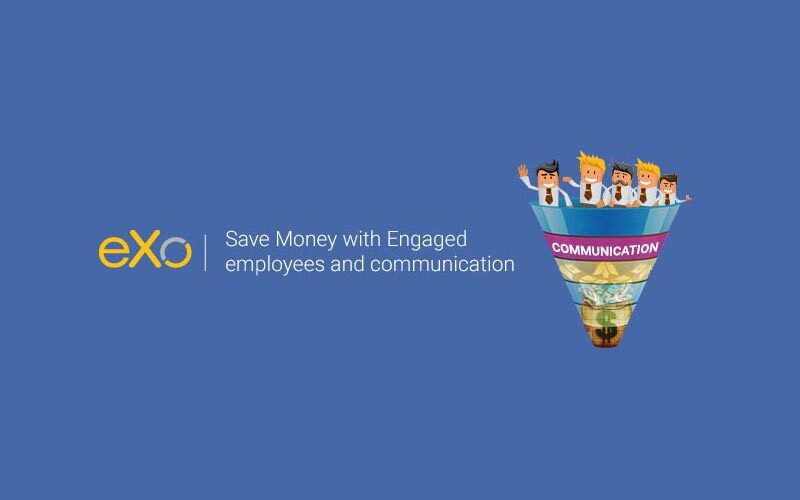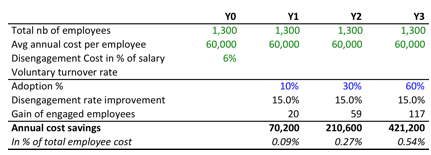- Veronika Mazour
- April 27, 2016
Benefits of Internal Communications on Employee Engagement
If you are in internal communications, the concept of employee engagement should be very familiar to you. Since 70% of all business leaders believe employee engagement is critical to their organisation success (CLC), employee engagement is one of the top five areas of focus for most internal communication departments and is used widely to attach a solid business value to communications.
The same logic and principles apply when evaluating the financial effects of a collaborative intranet on employee engagement.

Content
1. What is employee engagement?
Employee engagement is not easy to define or measure. In a nutshell, an employee is engaged if he or she goes the extra mile for his or her company. Staying an extra hour to finish a task, helping another department without seeing an immediate personal gain and wearing the company t-shirt on the weekend are all signs of engaged behavior. AON mentioned the three-S model: Say, Stay and Strive. An engaged employee says positive things about his or her company, stays there for a long time and strives to do his or her best at all times.
Many job satisfaction contributors can influence employee engagement, including a positive work environment, motivating management and visible career opportunities. However, if employee satisfaction appears to be a necessary prerequisite to engagement, an employee can be satisfied but not engaged.
2. How does employee engagement translate into financial benefits?
A number of studies have shown a correlation between employee engagement and financial performance indicators, such as revenue growth, operating margin and shareholder return.
- Engaged employees stay with their companies, thus saving turnover costs (see our post on turnover) and bringing their experience to the table, an amount that is much less easy to quantify. Engaged employees are 87% less likely to leave the organisation than the disengaged (CLC).
- Engaged employee take fewer sick days. A Gallup study (2003) consolidating data from 23,000 business units revealed that engaged employees take an average of 2.69 sick days a year vs. the 6.19 days that disengaged employees take. Engaged employees simply work more and better. Gallup also reported that business units with high engagement scores averaged 18% higher productivity and 12% higher profitability.
All the above factors directly influence your bottom line and operating margin—better performance means less costs. However, it also means higher revenues. For example, AON reported a positive correlation between employee engagement and financial performance. Organisations in the top quartile for engagement report growth 4% higher than the average, while organisations in the bottom quartile perform 1% poorer. Companies with high engagement levels report 23% better revenues than their counterparts
3. How can you calculate employee engagement benefits for your organisation?
Organisations that measure employee engagement or disengagement costs are rare.
While the costs and benefits of employee engagement are very real, the relative trend is more important than absolute values of engagement rate, for example. With this in mind, how can we calculate the benefits of an employee engagement initiative, such as introducing a collaborative intranet? Outside of the easy to get information about your total employee count and average employee cost, you need to make three assumptions.
Let us start with a benchmark estimation: a disengaged or passive employee costs you a minimum of 6% of his or her annual cost. That comes down to saying that a disengaged employee works 6% less than an average employee. Between sick days, slow work pace, etc., that estimate is on the low side.
If your business is in line with the average engagement rates in your region, chances are that your engagement rate can be sharply improved. In practice, our clients report very different improvement rates on engagement metrics, varying from as low as 5% to as high as 50% depending on a number of factors. These factors range from the initial engagement situation to overall internal communication performance and focus on employee engagement. We usually suggest making a 15% improvement assumption on the low side.
The last assumption we need to make is linked to the new intranet adoption rate every year. The example is based on our standard average.
As you can see in the example below, you do not need to measure your precise engagement rate to estimate the financial benefits of boosting employee engagement. With our assumptions above, you would save 0.5% of your total employee costs by year three.

4. How can you realize internal communication costs savings?
In addition to potentially boosting your employee engagement, a successful collaborative intranet also lowers the costs of your internal communications.
Think about the way in which you communicate top-down right now. If users shun your intranet, you probably rely heavily on email and physical supports for information flow. Try to list all the time and hard costs associated with this process. How many emails do you send per week/month/year? Assuming an interruption of at least one minute per email (time lost between reading the communication and coming back to the original task), how much does this cost your readers? What about the costs of paper, color printing, physical circulation, etc.? How would all this change if you acquired a strong reach platform through your collaborative intranet? How much would you save?
5. How can you measure employee engagement?
Let’s assume you introduced an employee engagement initiative, whether it’s a user-centered intranet or a communication campaign. How would you measure the improvement rate?
While annual engagement surveys would be the natural place to start, they tend to show an overly optimistic view of engagement. Therefore, other metrics can be used to complement the survey information, including work outside normal business hours, connexions and time spent with people outside the employee team, the number of cross-team collaboration initiatives, etc. That is where your collaboration platform can allow you to be creative and help you track some of those metrics.
eXo Platform 6 Free Datasheet
Download the eXo Platform 6 Datasheet and
discover all the features and benefits
discover all the features and benefits
5/5 - (1 vote)
I am the Chief Executive Officer of eXo Platform (the open source digital workplace platform), a company that I co-founded while in college and that I came back to after several years in the banking and consulting industry. I blog about modern work, about open-source and sovereignty issues. Occasionally, I also blog about my personal areas of interest, such as personal development, work–life balance, sustainability and gender equality.
Related posts
- All
- eXo
- Digital workplace
- Employee engagement
- Open source
- Future of work
- Internal communication
- Collaboration
- News
- intranet
- workplace
- Knowledge management
- Employee experience
- Employee productivity
- onboarding
- Employee recognition
- Change management
- Cartoon
- Digital transformation
- Infographic
- Remote work
- Industry trends
- Product News
- Thought leadership
- Tips & Tricks
- Tutorial
- Uncategorized
Leave a Reply
( Your e-mail address will not be published)



The best employee management software for your business